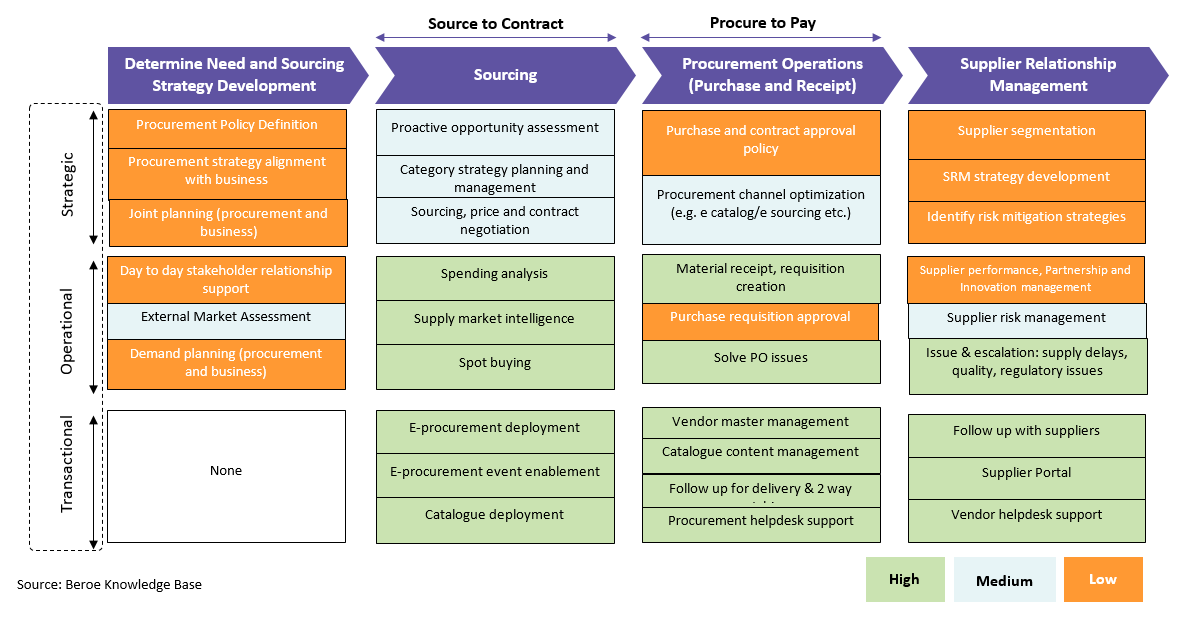
Choosing the Right Procurement Outsourcing Model | Beroe


Abstract
Procurement has transformed from a mere functional role to a more strategic role and organizations have become more experienced and matured in outsourcing. The perspective of mature procurement organizations has changed from visualizing Procurement Outsourcing as a medium for performing procurement activities in low cost countries to a more strategic step focusing on overall spending and managing the process effectively. With a broader perspective now, they are trying to benefit from Procurement Outsourcing in terms of both cost and quality.
Mature procurement organizations have been adopting the concept of shared services for some of the core-spending areas along with the option of outsourcing to third parties. Some organizations that have achieved cost benefits are interested in realizing other benefits that add value to the procurement process by outsourcing from shared services to third party PO companies. Considering this evolving trend, Procurement Outsourcing service providers have come up with solutions targeting the organization’s current operations and specific needs. This article sheds some light on how organizations that already have a Shared Service Centre can benefit from outsourcing the activities to the PO service provider.
Procurement Activities Outsourced by Organizations
Organizations having an onshore/in-house team heavily outsource transactional and operational activities compared to strategic activities as the authority to create strategies for indirect categories still lies within the control of the in-house team.

Procurement Outsourcing Services Model
Procurement Outsourcing service providers are now providing a more tailored solution model to meet customers’ specific needs.
-
By process: Instead of outsourcing the entire procurement function, the companies can now outsource specific categories, even a single function in P2P process or S2C process rather than availing off-the-shelf solutions.
-
By operating model: Procurement organizations are flexible in terms of offering their services to clients (i.e., they can take up the tasks from the procurement in-house team and perform the activities from their delivery centers/manage the organization’s Shared Service Centre and standardize the procurement activities for a fixed duration/completely re-badge the organization’s Shared Service Centre and manage its operations and employees).

Choosing the Right Outsourcing Model
Organizations that lack a Shared Service Center can directly outsource the activities to the PO companies. Few organizations that have a matured Shared Service Center in low cost countries also prefer to outsource some activities to see higher benefits. Such companies can opt for a Managed Services model. PO service providers can be initially engaged to manage the organization's SSC to standardize process and implement technology for automation and AI, post which the organization can continue managing their SSC.
Though companies have skilled resources to perform the activities in the S2P cycle from a SSC, they might lack next generation technologies and expertise to improve and streamline the process within a short period of time. PO service providers, through their expertise with clients across various levels of maturity, can rightly address the pain points of the company and streamline the process within a short period of time. The table below summarizes the key elements of each operating model/service offered by PO service provider.
| Managed Service | Re-badging | Complete Procurement Outsourcing | |
|
Suitability |
Focus is to retain and see higher benefits from SSC on a long term under a third party’s guidance |
When SSC is not in low cost country and existing FTEs are not completely expendable |
Suitable for companies focusing on scalability, transformation and innovation |
|
People |
Value addition- Medium- High (in the long term) SSC FTEs retained and trained by the Service Provider- value addition seen after 1-2 years |
Value addition
|
Value addition
|
|
Process |
Standardization-achievable in 2 years |
Standardization-achievable within 1-1.5 years |
Standardization-achievable within 1-1.5 years |
|
Tools |
Use their advanced in-built RPA and AI tools (or) customize existing tools based on client needs |
Use their advanced in-built RPA and AI tools |
Use their advanced in-built RPA and AI tools |
|
Cost Savings |
Medium-High (in the long term) Cost savings achieved after 2 years as a result of
|
Medium
|
Low- Medium
|
|
Pros |
|
|
|
|
Cons |
Resistance from SSC FTEs to adapt to new process and technology |
Re-badging to attain cost savings can impact reputation of the company |
|
|
Systems & Technologies used by Procurement Outsourcing Service Providers to Automate the S2P Process |
||
The following are the objectives that service providers are striving to achieve for their client companies, for automation across procurement operations processes |
||
|
Objectives/ Levers |
Expertise, Systems, and Resources to Support Clients |
Market Maturity and Adoption |
|
Simplification |
|
High-process improvement and streamlining of practices are imbibed into many of the existing Procurement Outsourcing engagements by service providers and the adoption is steady |
|
Automation |
|
|
|
Intelligence |
|
High-Service providers have invested heavily and the market is yet to see holistically mature offerings |
Cost Savings
Cost savings achieved by outsourcing the operations from a SSC to a PO service provider is measured in terms of:
- Reduction in Operating cost—FTE cost and administration cost
- Harmonization like elimination of redundant steps in S2P processes
- Common systems and tools across locations
- Standard contract terms and discount terms with vendors
Note: The exact savings percentage by outsourcing from SSC depends on several specific parameters (SSC operations cost: total cost for managing the SSC per annum, SSC FTE count, FTE cost, projected FTE reduction% etc.) and service provider parameters such as their FTE cost based on type of activity, system cost, etc.
Conclusion
The suitability of managed service/re-badging/complete outsourcing models is based on a company’s current scenario, needs, and requirements. The major decision criteria to move to one of the aforementioned models by outsourcing activities from Shared Service Center would be process standardization, S2P process efficiency, and supplier capabilities to automate and digitize the process through automation and artificial intelligence. However, an organization should outsource only if the PO service provider is able to pass on the benefits of cost reduction owing to automation and digitization of process to the organization.
References
https://www.capgemini.com/resources/research-procurement-outsourcing-managing-indirect-spend/
Related Insights:
View All
Get more stories like this
Subscirbe for more news,updates and insights from Beroe







M